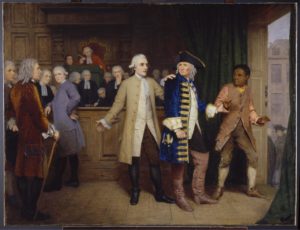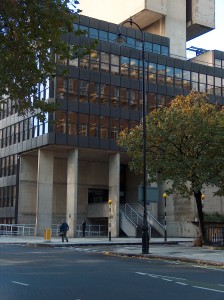By Dermot Feenan, Associate Research Fellow (IALS)
Introduction
The death of George Floyd during an arrest in the US in May 2020 has accelerated international examination of, and reaction against, racism and the continuing legacies of slavery. The toppling of the statute of slave trader Edward Colston in England two weeks later is part of that ongoing reaction. An article by lawyer and writer David Allen Green just over a month after these events was a reminder of the role of law and lawyers in sustaining slavery.
Green notes how lawyers advised slave owners. He also recalls the notorious 1729 ‘Yorke-Talbot Opinion’. The Attorney General, Sir Philip Yorke, and Solicitor General, Charles Talbot, wrote that, inter alia, a slave’s status did not change upon arrival in England and baptism would not free a slave.
Green observes that the horrors of slavery were normalised in cases prior to the Slavery Abolition Act 1833, including in the Zong case (1783) – where a slave ship on the Middle Passage lost direction due to a navigational error and, with drinking supplies low and sickness spreading, over one hundred slaves were thrown overboard and drowned. It was believed that no insurance would be paid if they died on board. The ship owners claimed insurance on the basis that the slaves were simply cargo, necessarily jettisoned in order to protect those who remained on board.
Green also writes of the centrality of ‘the miseries of slavery and imperialism […] to our national history’. That legacy lives on, including through the investments and inheritances from statutory compensation for slave owners following the 1833 Act – as documented in UCL’s Legacies of British Slave-ownership database.
Green’s article helped extend general awareness of the relationship between slavery and the legal profession. There is significant evidence of more personal involvements.
Abolitionists
A number of lawyers were leading figures in abolitionism. James Stephen (1758-1832), admitted to Lincoln’s Inn in 1775 and called to the Bar in 1782, is regarded as the chief architect of the Slave Trade Act 1807.
Daniel O’Connell (1775-1847), attended both Lincoln’s Inn and Gray’s Inn before transferring to King’s Inn in Dublin and being called to the Irish Bar in 1798. He may be best remembered as ‘The Liberator’ for his role as MP in securing Catholic Emancipation in 1829, but he also played a vital role in the abolition movement in the United Kingdom of Great Britain and Ireland and in the US.
O’Connell marshalled the votes of many Irish MPs on abolition bills. He also famously shared a platform with Frederick Douglass, the most prominent abolitionist in the US, when the latter visited Ireland in 1845.
Pro-slavery
The name David Lisle, lawyer and planter, may be obscure to many but it was his pistol-whipping of ‘Strong’ in London in 1765, which led to the intervention of Granville Sharp, a leading abolitionist, to ultimately ensure Strong’s freedom. One incident in Sharp’s involvement on behalf of Strong – ensuring his release following proceedings before the Lord Mayor – is captured in James Hayllar’s much later painting of 1864.
Oil painting, ‘Granville Sharp the abolitionist rescuing a slave from the hands of his master’
by James Hayllar, 1864. © Victoria and Albert Museum, London
In 1752, Edward Long became a law student at Gray’s Inn. From 1757 until 1769 he was resident in Jamaica. He became an established Jamaican planter and slave owner. He also became a judge in the local vice admiralty court before returning to England. His three-volume The History of Jamaica, published in 1774, is significant in large part because it both reflected but also helped to consolidate the ideology of the racialised inferiority of Black people which enabled slavery and which persists today.
Prior to the American Revolutionary War, many young men wishing to practise law in the American colonies travelled to and studied at the Inns of Court before returning across the Atlantic. Records show those who came from slave plantations and returned to own slaves and inherit plantations. Some, like John Faucheraud Grimké (1752–1819) from South Carolina, became judges.
Reckoning with the past: recognition, regret, apology and reparation
Following the toppling of Colston’s statue, a number of firms acknowledged their connection to slavery. Farrer & Co issued a statement expressing ‘regret’ at the role one of its founders played in the slave trade. Oliver Farrer acted as a trustee for George Watson Taylor, an English MP and sugar planter, who received over £30,000 (about £3.8 million today) in compensation for the loss of slaves on his seven estates. Freshfields Bruckhaus Deringer had already noted in 2009 that James William Freshfield, one of the original partners, financially benefited from slavery by acting as a trustee and owner-in-fee for several slave owners.
Acknowledging historical facts is one thing. Apologising and making amends for the symbolic and material harms caused by slavery is another. It’s not enough to issue statements of regret, reiterate what are existing legal obligations regarding promotion of equality, and trot out public relations-speak on inclusion and diversity.
In 2013, the CARICOM Reparations Commission was created to establish the moral, ethical and legal case for the payment of reparations by the Governments of all the former colonial powers and the relevant institutions of those countries, to the nations and people of the Caribbean Community for the Crimes against Humanity of Native Genocide, the Trans-Atlantic Slave Trade and a racialized system of chattel Slavery. It has issued a ten-point reparation plan.
In 2018, the University of Glasgow reported receiving significant financial gifts and support from people who derived some or occasionally much of their wealth from slavery. In 2019, it committed to raising and spending £20 million over the following 20 years in reparative work, including through the creation of a Glasgow-Caribbean Centre for Development Research, a joint initiative with the University of the West Indies. The Centre’s mission is to host events and activities, sponsor research work, coordinate academic collaborations with other universities, and help to stimulate public awareness about the history of slavery and its impact around the world.
Similarly, though less ambitiously, Lloyds of London, one of whose founder subscriber members was given the equivalent of £400,000 for an estate in Dominica and which insured slave ships, announced a number of reparative initiatives including “financial support to charities and organisations promoting opportunity and inclusion for black and minority ethnic groups.”
Further research in law
Little has been published on the role of lawyers, the legal profession, and legal institutions in relation to slavery. The broad case for uncovering such history and for reparative reckoning has already been made out elsewhere. It is an area deserving of further work.
@DermotFeenan2020
Dermot Feenan is an Associate Research Fellow at the Institute of Advanced Legal Studies.


